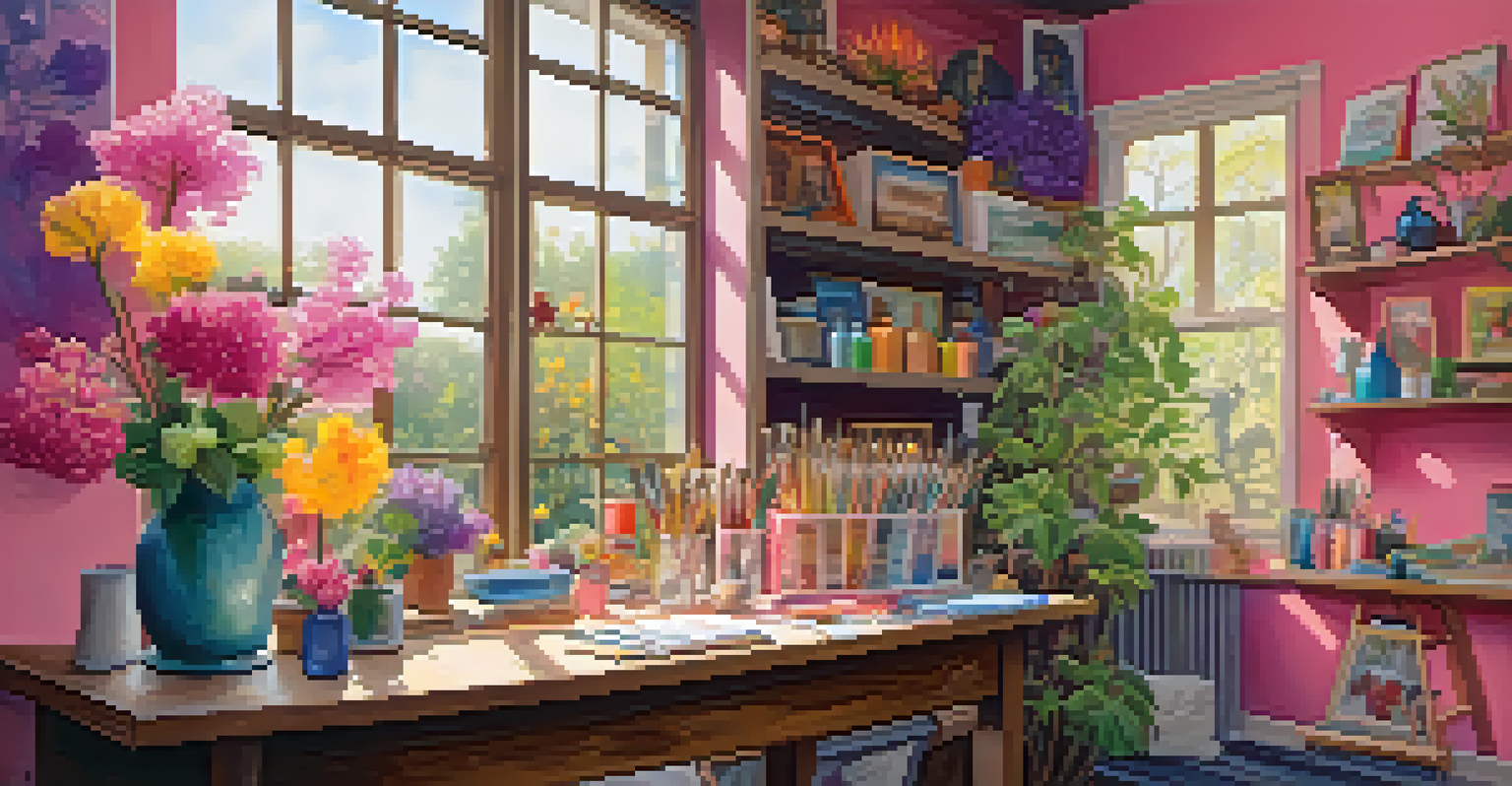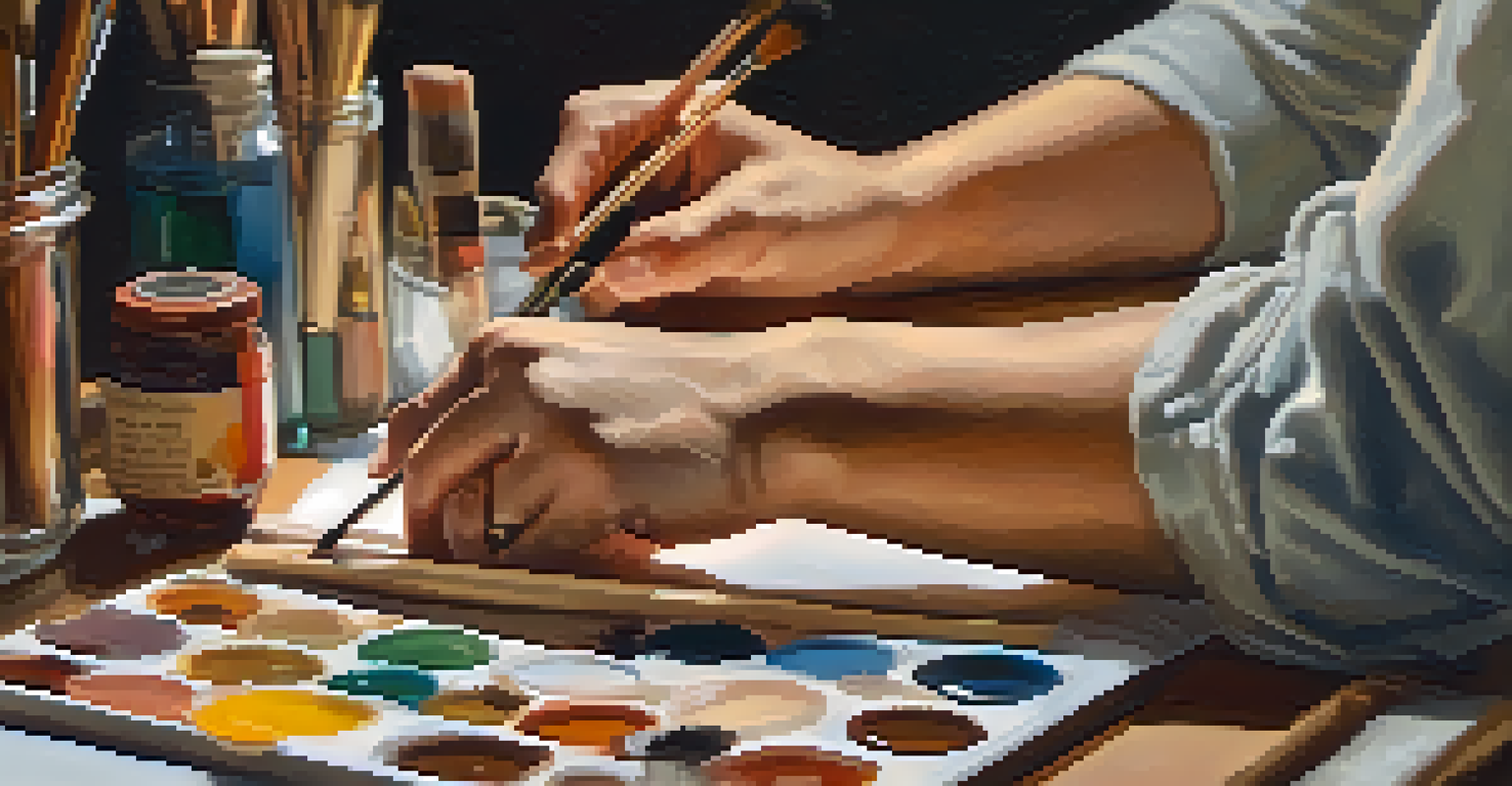Painting as a Vehicle for Recollecting Past Experiences

The Emotional Connection of Colors in Painting
Colors have an incredible ability to evoke emotions and memories. For instance, a deep blue might remind you of a calm lake from your childhood, while a vibrant yellow could bring back sunny afternoons spent outdoors. This emotional connection can be harnessed through painting, allowing artists to explore and articulate their past experiences.
Color is the keyboard, the eyes are the harmonies, the soul is the piano with many strings.
When you pick up a brush, the colors you choose often reflect your mood and memories. An artist might find themselves drawn to a specific palette that resonates with a cherished moment, creating a visual representation of their emotional landscape. This process not only facilitates recollection but also serves as a form of self-expression.
By consciously selecting colors that remind you of specific experiences, painting becomes a therapeutic tool, helping to unpack complex feelings related to those memories. Each stroke can serve as a bridge to the past, allowing for both reflection and healing.
Capturing Moments Through Brushstrokes
Every painting tells a story, often rooted in the artist's personal history. Whether it's a landscape that mirrors a favorite vacation spot or a portrait of a loved one, these artworks serve as visual diaries of our lives. By recreating these moments on canvas, artists can revisit the emotions tied to those experiences.

For example, an artist might paint a scene of their grandmother's garden, filled with blooming flowers and a sense of nostalgia. In doing so, they not only capture the essence of that memory but also preserve it for future reflection. This act of creation can be both a personal tribute and a way to share those memories with others.
Colors Evoke Emotions in Art
Artists use color choices in painting to express personal memories and emotions, enhancing their creative journey.
Moreover, these paintings can spark conversations and connections with viewers who may have shared similar experiences. Art becomes a communal language, allowing individuals to bond over their own memories, thus enhancing the recollective power of painting.
The Therapeutic Power of Artistic Expression
Engaging in painting can provide significant therapeutic benefits, especially when exploring past experiences. The act of creating art allows for an emotional release, helping individuals process complex feelings related to their memories. This release can lead to a deeper understanding of oneself and one's history.
Art is a journey into a world that one creates, and it is in this world that we can find ourselves.
Art therapy, a practice that incorporates creative expression, has been shown to aid in mental health recovery. For those grappling with trauma or loss, expressing emotions through painting can be a crucial step toward healing. The canvas becomes a safe space for exploring and confronting feelings that might otherwise remain buried.
By channeling emotions into art, individuals often find clarity and resolution. The journey of painting can transform painful memories into a narrative of resilience, showcasing the power of artistic expression as a means of emotional healing.
Finding Inspiration in Personal Artifacts
Personal artifacts, such as photographs or mementos, can serve as powerful sources of inspiration for painting. By reflecting on these items, artists can unlock memories that may have been forgotten or overlooked. This process can lead to a richer, more meaningful artistic experience.
For instance, an old photograph from a family gathering might inspire a scene that captures the essence of that moment. The artist can infuse their painting with emotions and details that may not be evident in the photograph itself, providing a unique perspective on a cherished memory.
Art as a Therapeutic Tool
Creating art allows individuals to process complex feelings and experiences, promoting emotional healing and self-discovery.
Using personal artifacts as a foundation for artwork not only enhances creativity but also deepens the emotional connection to the piece. This approach allows for a more authentic exploration of one's past, making the finished work a true reflection of the artist's journey.
The Role of Memory in the Creative Process
Memory plays a crucial role in the creative process, especially for artists looking to paint their past experiences. Each recollection can shape the themes, colors, and emotions that emerge on the canvas. This interplay between memory and creativity is what makes each artwork unique and deeply personal.
As artists delve into their memories, they often find unexpected connections and insights. A seemingly mundane detail from the past can inspire a profound piece of art, revealing layers of meaning that resonate both personally and universally. This process highlights how memories can serve as a wellspring of creativity.
Moreover, the act of painting itself can help solidify and reshape memories. By translating thoughts and feelings into visual form, artists can gain a new perspective on their past, transforming experiences into stories that can be shared with others.
Sharing Stories Through Art Exhibitions
Art exhibitions provide a platform for artists to share their personal stories and memories with a broader audience. Displaying paintings that reflect past experiences invites viewers into the artist's world, fostering a deeper understanding of their journey. This act of sharing can be both empowering and cathartic.
In exhibitions, artists can curate their work in a way that highlights specific narratives or themes, inviting viewers to engage with the stories behind each piece. This interaction can spark conversations about shared experiences, allowing for collective healing and connection.
Sharing Stories Through Art
Art exhibitions enable artists to connect with audiences by sharing personal narratives, fostering community and collective reflection.
Moreover, sharing art publicly can validate an artist's experiences and emotions, reinforcing the idea that memories are universal. This sense of community can create a supportive environment for both the artist and the audience, emphasizing the importance of storytelling through art.
The Lasting Impact of Artistic Reflection
The impact of painting as a vehicle for recollecting past experiences extends beyond the canvas. For many artists, creating art provides a sense of closure and understanding, allowing them to move forward while cherishing their memories. This reflective process can be transformative, shaping future creative endeavors.
Additionally, the act of reflecting on past experiences through art can inspire others to do the same. Viewers may find themselves contemplating their own memories and experiences, igniting a spark of creativity within them. The cycle of reflection and inspiration is a powerful aspect of the artistic process.

Ultimately, painting serves as a reminder that our past experiences shape who we are today. By engaging with those memories through art, we can celebrate our history while also paving the way for new stories to unfold.